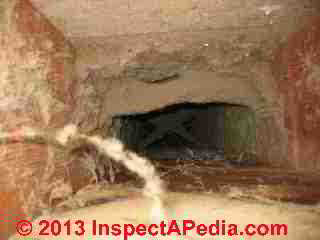 HVAC Air Duct Contamination
HVAC Air Duct Contamination
Causes, Detection, Cleaning, Prevention of bacterial, dirt, insect, mold or other duct contaminants - resource list
- POST a QUESTION or COMMENT about contamination of air ducts in cooling or heating systems
Contamination in air conditioning or heating ducts:
List of HVAC air duct contamination sources & types, diagnostic articles & duct contaminant or odor detection, testing & contaminant removal or prevention advice.
InspectAPedia tolerates no conflicts of interest. We have no relationship with advertisers, products, or services discussed at this website.
- Daniel Friedman, Publisher/Editor/Author - See WHO ARE WE?
Contaminants in HVAC Air Ducts
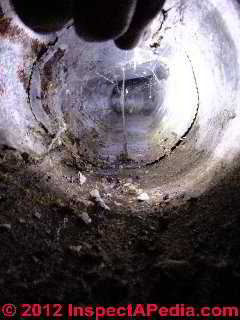 This article is the topic index to our article series addressing just about every common source of contamination in heating & cooling duct systems, including bacteria, dust, fiberglass fragments, mold or odors that appear to originate in or be transported by the buildings air duct system.
This article is the topic index to our article series addressing just about every common source of contamination in heating & cooling duct systems, including bacteria, dust, fiberglass fragments, mold or odors that appear to originate in or be transported by the buildings air duct system.
[Click to enlarge any image]
My photo at page top shows a fiberglass-lined HVAC duct that was tortured and damaged by an attempt at mechanical cleaning. The result of such treatment is likley to include the blowing of irritating, potentially harmful fiberglass fragments into the building indoor air.
The photo shown just above illustrates an in-slab air duct that was not only quite dirty but that had been repeatedly flooded.
My OPINION is that water in air ducts invites growth of more-serious mold, bacterial contamination and possibly other pathogens, particularly if the duct was flooded during an area flood that brought sewage waters into a building.
Below is an alphabetical list of common air duct contaminants and contamination sources or duct test & inspection methods.
Following our list of duct contaminant diagnostic articles we illustrate and discuss some common examples of air duct contamination, dust, dirt and debris - or perhaps of more concern, pathogens.
Watch out: don't panic if you see dust inside the HVAC system, or exposed fiberglass. Both of these conditions are common and do not necessarily mean that the air ducts are unsanitary or unsafe.
However if you see signs of water, visible mold, flooding, rodents, or if you see that the duct interior has been damaged like the fiberglass-lined duct shown a the top of this page there may indeed be a problem that needs to be addressed.
See details at DUCT DAMAGE, MECHANICAL
Article Series Contents
- DUCTWORK CONTAMINATION
- ASBESTOS DUCTS, HVAC
- DUCT & AIR HANDLER ODORS
- DUCT in CONCRETE FLOOR
- DUCT DAMAGE, MECHANICAL
- DUST, HVAC CONTAMINATION STUDY
- FIBERGLASS HVAC DUCTS
- FIBERGLASS INSULATION MOLD
- Legionella BACTERIA & HVAC EQUIPMENT
- MOLD APPEARANCE on VARIOUS SURFACES that includes this image Mold on/in Air Ducts
- OZONE MOLD / ODOR TREATMENT WARNINGS
- AIRBORNE PARTICLE & MOLD LEVELS in DUCTWORK
- RESTORE UTILITIES AFTER FLOODING
- SEWAGE CONTAMINATION in BUILDINGS
- SLAB DUCTWORK
- STAINS at HVAC REGISTERS
- STAINS HVAC SOOT or DUST
- UV DISINFECTION in HVAC SYSTEMS
- UNSAFE DUCT OPENINGS
- WATER & ICE IN DUCT WORK
- WET CORRODED DUCT WORK
- WHY DOES MOLD GROW in INSULATION?
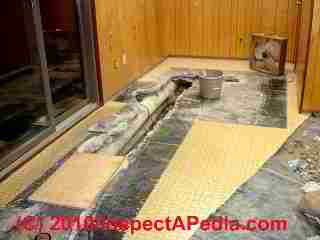
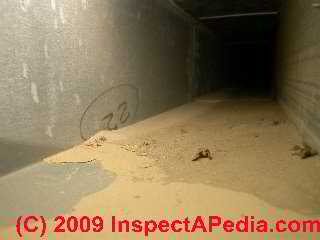
At above left we show transite HVAC ducts routed in a floor slab immediately over a sewer line. When the sewer line leaked sewage odors were picked up in and transported by the in-slab ductwork.
Details of this case are presented at SLAB DUCTWORK.
At above right we illustrate an air duct that was routed below the first floor of a buildnng and accessible from the basement.
A look inside showed us that there had been of a history of flooding - dirt and mud on the duct bottom - meaning that floodwaters had at one time filled the basement.
Watch out: area flooding may contaminate ductwork with sewage or other pathogens even for above-ground-level HVAC ducts, while a building sewage backup can certainly contaminate ductwork run in floors or in a floor slab.
See SEWAGE CONTAMINATION in BUILDINGS.
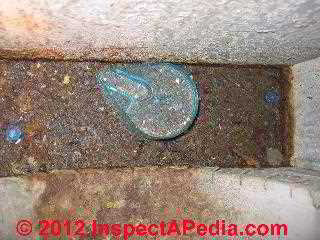
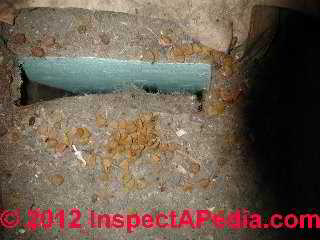
At above left we illustrate an abandoned HVAC duct in a concrete floor slab. It's quite apparent that the area remains wet along with an added risk of contaminants of sewage, pesticides, rodents, insects, or anything that spilled on the floor in this area.
Our HVAC duct interior photograph at above right shows a melange of contamination by animal hair, dog food, and rodent droppings. Mice were eating the dog food that spilled into this return air duct opening at a floor register. The potential pathogens invovled here include at least bacteria, possibly hantavirus and mold.
Research & Resources on Contaminated HVAC Ducts / Heating or Air Conditioning Ductwork
- Ahmad, Irtishad, Berrin Tansel, and Jose D. Mitrani. "Effectiveness of HVAC duct cleaning procedures in improving indoor air quality." Environmental monitoring and assessment 72, no. 3 (2001): 265-276.
Abstract: Indoor air quality has become one of the most serious environmental concerns as an average person spends about 22 hr indoors on a daily basis. The study reported in this article, was conducted to determine the effectiveness of three commercial HVAC (Heating Ventilation Air Conditioning) duct cleaning processes in reducing the level of airborne particulate matter and viable bioaerosols. The three HVAC sanitation processes were:
(1) Contact method (use of conventional vacuum cleaning of interior duct surfaces);
(2) Air sweep method (use of compressed air to dislodging dirt and debris);
(3) Rotary brush method (insertion of a rotary brush into the ductwork to agitate and dislodge the debris).
Effectiveness of these sanitation processes was evaluated in terms of airborne particulate and viable bioaerosol concentrations in residential homes. Eight identical homes were selected in the same neighborhood.
Two homes were cleaned using each procedure and two were used ascontrols.
It was found that both particle count readings and bioaerosol concentrations were higher when cleaning was being performed than before or after cleaning, which suggests that dirt, debris and other pollutants may become airborne as a result of disturbances caused by the cleaning processes.
Particle count readings at 0.3 micron size were found to haveincreased due to cigarette smoking. Particle counts at 1.0micron size were reduced due to HVAC duct cleaning.
Post-level bioaerosol concentrations, taken two days after cleaning, were found to be lower than the pre-level concentrations suggesting that the cleaning procedures were effective to some extent.
Homes cleaned with the Air Sweep procedure showed the highest degree of reduction in bioaerosol concentration among the three procedures investigated. - Batterman, Stuart, and Chi-ung Peng. "TVOC and CO2 concentrations as indicators in indoor air quality studies." American Industrial Hygiene Association 56, no. 1 (1995): 55-65.
Abstract:
This article reviews the sources, levels, and interpretation of CO2 and VOC concentrations in buildings. The use of an enrichment factor to identify emission sources and potential IAQ problems is suggested.
The indicator is evaluated by collecting concentration data in two office buildings and by reviewing recent air-quality studies in the literature. Results show that bioeffluent and occupant-related emissions often account for a large share of VOC emissions; the suggested indicator clearly shows when other sources are significant.
Several issues that influence the interpretation of IAQ indicators are discussed, including the use of pollutant surrogates, temporal and spatial variability in large buildings, VOC measurement technique, and outdoor pollutant levels.
Watch out: OPINION: while the presence of MVOCs can be reliably taken to indicate that there is a mold reservoir in a building, the absence of MVOCs cannot permit concluding that there is no mold contamination issue. Not all molds generate high levels of MVOCs and even those that do may not produce high levels of MVOCs consistently over time, as building indoor environmental conditions including temperature and humidity vary - Editor [DF] - Bluyssen, Philomena M., Christian Cox, Olli Seppänen, Eduardo de Oliveira Fernandes, Geo Clausen, Birgit Müller, and Claude-Alain Roulet. "Why, when and how do HVAC-systems pollute the indoor environment and what to do about it? The European AIRLESS project." Building and Environment 38, no. 2 (2003): 209-225.
Abstract: From 1998 to 2000, a European project named AIRLESS was conducted by 12 institutes, universities and companies from seven European countries.
The objective was to develop strategies, principles and protocols to improve and control the performance of HVAC-systems and its components for incorporation in codes and guidelines. The first step was to define air pollution caused by and/or originating from HVAC-systems, to investigate ways to prevent this pollution and to define strategies to keep this pollution away. A summary of this first phase of the AIRLESS project is presented. - Bonetta, Sa, Si Bonetta, S. Mosso, S. Sampò, and E. Carraro. "Assessment of microbiological indoor air quality in an Italian office building equipped with an HVAC system." Environmental monitoring and assessment 161, no. 1 (2010): 473-483.
- Buttner, Mark P., Patricia Cruz-Perez, Paula J. Garrett, and Linda D. Stetzenbach. "Dispersal of fungal spores from three types of air handling system duct material." Aerobiologia 15, no. 1 (1999): 1-8.
Abstract:
Exposure to airborne microorganisms in indoor environments may result in infectious disease or elicit an allergic or irritant response. Air handling system components contaminated by fungi have been implicated in the dispersal of spores into the indoor environment, thereby serving as a route of exposure to occupants.
This study was conducted to provide quantitative data on the dispersal of spores from fungal colonies growing on three types of duct material. Galvanized metal, rigid fibrous glass ductboard, and fiberglass duct liner were soiled and contaminated with a known concentration of Penicillium chrysogenum spores.
The duct materials were incubated in humidity chambers to provide a matrix of growing, sporulating fungal colonies at a contamination level of 109 colony forming units (CFU) per duct section, consistent for all materials. For each experiment a contaminated duct section was inserted into the air handling system of an experimental room, and the air handling system was operated for three 5-minute cycles with an air flow of 4.2 m3 min−1. The duct air velocity was approximately 2.8 m sec−1.
The airborne concentration of culturable P. chrysogenum spores (CFU m−3), total P. chrysogenum spores (spores m−3), and total P. chrysogenum-sized particles (particles m−3) were measured in the room using Andersen single-stage impactor samplers, Burkard slide impactor samplers, and an aerodynamic particle sizer, respectively.
The highest airborne concentrations (104 CFU m−3; 105 spores m−3; 104 particles m−3) were measured during the first operating cycle of the air handling system for all duct materials with decreasing airborne concentrations measured during the second and third cycles. There was no significant difference in spore dispersal from the three contaminated duct materials.
These data demonstrate the potential exposure for building occupants to high concentrations of spores dispersed from fungal colonies on air handling system duct materials during normal operation of the system. - Collett, C. W., and K. Baer. "THE IMPACT OF HVAC SYSTEM CLEANING ON LEVELS OF SURFACE DUST AND VIABLE FUNGI IN DUCTWORK." [PDF] (1999). Retrieved 2017/11/03, original source: http://www.aivc.org/sites/default/files/airbase_12964.pdf
Abstract:
Samples of surface dust were collected frorp ducts before and after an HV AC system cleaning project in an office complex in Canada. Dust levels were quantified gravimetrically and concentrations of viable fungi were determined
(1) using a standard dilution plating method from vacuum-collected surface dust samples; and
(2) by the collection of surface samples on commercially available agar contact slides.
A decrease in surface dust concentrations from 120.9 ±50.1 mg/100cm2 to less than 0.1 mg/100cm2 was observed throughout the HVAC systems following cleaning procedures.
The reduced dust levels within the HVAC system ductwork coincided with lower RSP concentrations within the office building.
Surface concentrations of viable fungi as determined by contact sampling procedures were reduced from a pre-cleaning average of 118 (±35) CFU/100cm2 to 23 (±4) CFU/100cm2 following cleaning.
Dilution plate analysis of pre- and post-cleaning vacuum-collected dust samples showed a similar overall decrease. However, this technique resulted in higher variance and considerably lower species diversity.
We propose that desiccation due to the high flow rate required by vacuum collection procedures negatively affected the viability of fungal propagules, accounting for the discrepancy. - FIBER & HAIR IDENTIFICATION in buildings
- Foarde, K. K., and M. Y. Menetrez. "Evaluating the potential efficacy of three antifungal sealants of duct liner and galvanized steel as used in HVAC systems." Journal of industrial microbiology & biotechnology 29, no. 1 (2002): 38-43.
Abstract:
Current recommendations for remediation of fiberglass duct materials contaminated with fungi specify complete removal, which can be extremely expensive, but in-place duct cleaning may not provide adequate protection from regrowth of fungal contamination.
Therefore, a common practice in the duct-cleaning industry is the postcleaning use of antifungal surface coatings with the implication that they may contain or limit regrowth.
However, even the proper use of these products has generally been discouraged because little research has been conducted on the effectiveness of most products as used in heating, ventilating, and air-conditioning (HVAC) systems.
Three different coatings were evaluated on fiberglass duct liner (FGDL). Two of the three coatings were able to limit growth in the 3-month study; the third did not.
One of the coatings that was able to limit growth was further evaluated in a comparison of FGDL or galvanized steel (GS) under conditions that mimicked their use in HVAC systems. The results showed that both moderately soiled and heavily soiled uncoated FGDL and GS duct material can support fungal growth, but that GS duct material was more readily cleaned.
The use of an antifungal coating helped limit, but did not fully contain, regrowth on FGDL. No regrowth was detected on the coated GS. - Foarde, Karin, Douglas VanOsdell, Eric Meyers, and John Chang. "Investigation of contact vacuuming for remediation of fungally contaminated duct materials." Environment international 23, no. 6 (1997): 751-762.
Abstract:
Environmental fungi become a potential Indoor Air Quality (IAQ) problem when adequate moisture and nutrients are present in building materials. Because of their potential to rapidly spread contamination throughout a building, ventilation system materials are of particular significance as potential microbial contamination sources. Current recommendations are to discard fibrous glass insulation that appears to be wet or moldy.
Unfortunately, this advice is not always followed. Instead, cleaning is sometimes being used in buildings to remediate fibrous glass duct liner that is already contaminated with microbial growth.
The objectives of this research program were to:
1) determine, under dynamic test conditions, whether fungal spore levels on heating, ventilating, and air-conditioning (HVAC) duct material surfaces could be substantially reduced by thorough vacuum cleaning,
2) evaluate whether subsequent fungal growth could be limited or contained by mechanical cleaning, and
3) provide data concerning the advisability of cleaning duct materials.
The constant high relative humidity (RH) environment to which the test materials were exposed during this study was selected as a favorable growth environment that is frequently found in Southeastern United States HVAC systems.
The results showed that, following cleaning, the levels of the two test fungi, A. versicolor and P. chrysogenum, recovered to preclean levels within 6 weeks. Therefore, mechanical cleaning by contact vacuuming alone was able to only temporarily reduce the surface fungal load. The current guidelines to discard contaminated materials should be followed. - Foarde, K. K., D. W. VanOsdell, and J. C. S. Chang. "Evaluation of fungal growth on fiberglass duct materials for various moisture, soil, use, and temperature conditions." Indoor Air 6, no. 2 (1996): 83-92.
Abstract
Fiberglass duct materials are commonly used in both residential and commercial heating, ventilation, and air-conditioning (HVAC) systems to provide the needed thermal insulation and noise control. Many building investigations have documented biocontamination of these materials, and the appropriateness of their use in high humidity locations has come into question.
A series of experiments, each lasting 6 weeks, was conducted in static environmental chambers to assess some of the conditions that may impact the ability of a variety of fiberglass materials to support the growth of a fungus, Penicillium chrysogenum.
Three different fiberglass duct liners (FDL), one fiberglass duct board, and fiberglass insulation, all newly purchased, were obtained as were samples of used (>5 years old) materials. Samples of these materials were tested to evaluate the effects of moisture, soil, use, and temperature on their ability to support the growth of P. chrysogenum.
These studies demonstrated that P. chrysogenum could amplify under conditions of low (12°C) and room (23°C) temperature and high relative humidity on samples of one of the newly purchased materials, and that either wetting and/or soiling increased the materials’ susceptibility.
P. chrysogenum was able to grow on all the used material samples. While the results of this study apply directly only to fiberglass duct materials, they suggest that dust accumulation and/or high humidity should be properly controlled in any HVAC duct to prevent the growth of P. chrysogenum. - Fox, Barry C., Lee Chamberlin, Patricia Kulich, Eleanor J. Rae, and Linda R. Webster. "Heavy contamination of operating room air by Penicillium species: identification of the source and attempts at decontamination." American journal of infection control 18, no. 5 (1990): 300-306.
- Krake, Ann M., Karen A. Worthington, Kenneth M. Wallingford, and Kenneth F. Martinez. "Evaluation of microbiological contamination in a museum." Applied occupational and environmental hygiene 14, no. 8 (1999): 499-509.
- Levetin, Estelle, Richard Shaughnessy, Christine A. Rogers, and Robert Scheir. "Effectiveness of germicidal UV radiation for reducing fungal contamination within air-handling units." [PDF] Applied and Environmental Microbiology 67, no. 8 (2001): 3712-3715.
Abstract:
Levels of fungi growing on insulation within air-handling units (AHUs) in an office building and levels of airborne fungi within AHUs were measured before the use of germicidal UV light and again after 4 months of operation.
The fungal levels following UV operation were significantly lower than the levels in control AHUs. [Underline emphasis is ours - Ed. ] - Li, Angui, Zhijian Liu, Xiaobin Zhu, Ying Liu, and Qingqin Wang. "The effect of air-conditioning parameters and deposition dust on microbial growth in supply air ducts." Energy and Buildings 42, no. 4 (2010): 449-454.
- Menetrez, M. Y., K. K. Foarde, T. R. Dean, and D. A. Betancourt. "The effectiveness of UV irradiation on vegetative bacteria and fungi surface contamination." Chemical Engineering Journal 157, no. 2 (2010): 443-450.
Abstract: Ultraviolet irradiation has been used in the indoor environment to eliminate or control infectious diseases in medical care facilities.
Heating, ventilating, and air-conditioning (HVAC) system components such as duct-liners, cooling coils, drip pans, interior insulation and areas subjected to high levels of moisture can create an environment which is prone to biological contamination on surfaces.
The movement of indoor air being dominated by HVAC system operation can carry biological contaminants which can expose large numbers of building occupants to bioaerosols.
The use of germicidal ultraviolet lamps (UVGI) in commercial and residential HVAC systems has increased. UVGI treatment has focused on HVAC component internal surfaces and airflow. A method to determine the antimicrobial efficacy of UVGI irradiation was developed and tested on the surface of agar plates with four species of vegetative bacteria and seven species of fungi.
The percent kill and the kinetics of the rate of killing, k value, were calculated for each organism. - Morrison, Glenn C., William W. Nazaroff, J. Alejandro Cano-Ruiz, Alfred T. Hodgson, and Mark P. Modera. "Indoor air quality impacts of ventilation ducts: ozone removal and emissions of volatile organic compounds." Journal of the Air & Waste Management Association 48, no. 10 (1998): 941-952.
Abstract:
The concentrations of contaminants in the supply air of mechanically ventilated buildings may be altered by pollutant emissions from and interactions with duct materials. We measured the emission rate of volatile organic compounds (VOCs) and aldehydes from materials typically found in ventilation ducts.
The emission rate of VOCs per exposed surface area of materials was found to be low for some duct liners, but high for duct sealing caulk and a neo-prene gasket. For a typical duct, the contribution to VOC concentrations is predicted to be only a few percent of common indoor levels. We exposed selected materials to ~100-ppb ozone and measured VOC emissions.
Exposure to ozone increased the emission rates of aldehydes from a duct liner, duct sealing caulk, and neoprene gasket. The emission of aldehydes from these materials could increase indoor air concentrations by amounts that are as much as 20% of odor thresholds. We also measured the rate of ozone uptake on duct liners and galvanized sheet metal to predict how much ozone might be removed by a typical duct in ventilation systems.
For exposure to a constant ozone mol fraction of 37 ppb, a lined duct would initially remove ~9% of the ozone, but over a period of 10 days the ozone removal efficiency would diminish to less than 4%. In an unlined duct, in which only galvanized sheet metal is exposed to the air-stream, the removal efficiency would be much lower, ~0.02%. Therefore, ducts in ventilation systems are unlikely to be a major sink for ozone.
Watch out: OPINION: see OZONE MOLD KILL TREATMENT - in our opinion using ozone as a cure for mold contamianation is a questionable approach. We alsowarn that over-dosing with ozne in a building interior can cause oxidation of various building materials that then present a new odor and off-gassing problem indoors even if the amount of such a secondary effect from the air ducts themselves is minimal (as these authors found). - Sextro, R. G., D. M. Lorenzetti, M. D. Sohn, and T. L. Thatcher. "Modeling the spread of anthrax in buildings." In Proceedings of Indoor Air 2002 Conference, Monterey, CA, pp. 506-511. 2002.
- Schleibinger, Hans, and Henning Rüden. "Air filters from HVAC systems as possible source of volatile organic compounds (VOC)–laboratory and field assays." Atmospheric Environment 33, no. 28 (1999): 4571-4577.
Abstract
The emission of volatile organic compounds (VOC) from air filters of HVAC systems was to be evaluated. In a first study carbonyl compounds (14 aldehydes and two ketones) were measured by reacting them with 2,4-dinitrophenylhydrazine (DNPH). Analysis was done by HPLC and UV detection. In laboratory experiments pieces of used and unused HVAC filters were incubated in test chambers.
Filters to be investigated were taken from a filter bank of a large HVAC system in the centre of Berlin. First results show that – among those compounds – formaldehyde and acetone were found in higher concentrations in the test chambers filled with used filters in comparison to those with unused filters. Parallel field measurements were carried out at the prefilter and main filter banks of the two HVAC systems.
Here measurements were carried out simultaneously before and after the filters to investigate whether those aldehydes or ketones arise from the filter material on site. Formaldehyde and acetone significantly increased in concentration after the filters of one HVAC system. In parallel experiments microorganisms were proved to be able to survive on air filters.
Therefore, a possible source of formaldehyde and acetone might be microbes. - Wilson, Stephen C., Robert N. Palmatier, Larysa A. Andriychuk, Jared M. Martin, Cynthia A. Jumper, Homer W. Holder, and David C. Straus. "Mold contamination and air handling units." Journal of occupational and environmental hygiene 4, no. 7 (2007): 483-491.
Abstract: An investigation was conducted on selected locations in air handling units (AHUs) to
(a) identify common mold species found on these locations,
(b) determine whether some locations (and subsets) featured mold growth sites more frequently than others,
(c) ascertain whether the operating condition of AHUs is related to mold contamination, and
(d) provide a basis for a microbial sampling protocol for AHUs.
A total of 566 tape lifts and 570 swab samples were collected from the blower wheel fan blades, insulation, cooling coil fins, and ductwork from 25 AHUs. All AHU conditions were numerically rated using a heating, ventilation and air-conditioning (HVAC) survey.
Results showed that Cladosporium sp. fungi were commonly recovered in terms of growth sites and deposited spores, and they were found mainly in the blower wheel fan blades, the ductwork, and the cooling coil fins.
Subsections of the fan blades, insulation, and cooling coil fins showed no preferred area for mold growth sites. Other organisms such as Penicillium sp., Aspergillus sp., and Paecilomyces sp. were recovered from the cooling coil fins and insulation. Because of the widespread prevalence of Cladosporium sp., there was no relationship between mold growth and operating condition.
However, the presence of different species of molds in locations other than the blower wheel blades may indicate that the AHU condition is not optimal. A suggested microbial sampling protocol including interpretations of sample results is presented. - Zhao, Bin, and JiuJiu Chen. "Numerical analysis of particle deposition in ventilation duct." Building and Environment 41, no. 6 (2006): 710-718.
Abstract Excerpts: This paper adopts computational fluid dynamics (CFD) to numerically analyze particle deposition in the ventilation duct....
Twelve groups of particle size, two average air speeds in ducts are investigated to understand the particle deposition in the straight ventilation duct, which ensures a fully developed turbulent duct flow.
And then, the particle accumulation by deposition in the ventilation duct is analyzed according to the cleaning code for air duct system in heating, ventilation and air conditioning (HVAC) systems of China.
The cases with or without air filter installed are studied by assuming that the duct inlet particle concentration is that of outdoor air in Beijing city, China. The simulated results of dimensionless deposition velocity onto floor agree well with the measured data from others, while the discrepancies of vertical wall and ceiling are obvious.
Both the simulated results in this paper and measured data from literature show that particle deposition onto the floor (upward wall) in the ventilation ducts is the most significant.
The deposition velocity onto the floor is about 2 orders of magnitude larger than that onto the other walls of the duct. The filter is effective to defend the ventilation duct against particle pollution by deposition.
A higher efficiency filter is helpful to postpone the cleaning time for ventilation duct, so the filter should be replaced often to maintain the filter efficiency. - Zuraimi, Mohamed Sultan. "Is ventilation duct cleaning useful? A review of the scientific evidence." Indoor Air 20, no. 6 (2010): 445-457.
Abstract Ventilation duct cleaning (DC) is widely advocated to provide good indoor air quality (IAQ), health benefits, cost savings, and enhance ventilation system performance. The aim of the present review is to evaluate the scientific evidence as shown in the literature.
There is evidence that under normal operating conditions, ventilation ducts can be contaminated with dusts and serve as reservoirs for microbials to proliferate. While controlled experiments noted that contaminants resuspension can elevate exposure levels indoors, no field studies have correlated poor IAQ with duct contamination.
Despite high efficiencies of contaminant removal within the ducts during cleaning, reductions for different indoor air pollutants vary widely, where, post-cleaning air pollutants concentrations can be higher than pre-cleaning levels.
Further, there are health concerns in the use of biocides, sealants and encapsulants. There is inadequate evidence to show that DC can improve airflow in ducts and reduce energy consumption.
Although epidemiological studies indicate suggestive evidence that improperly maintained ducts are associated with higher risks of symptoms among building occupants, this review finds insufficient evidence that DC can alleviate occupant’s symptoms.
In summary, the need for duct cleanliness has to be properly balanced by the probable generation of indoor pollution resulting from DC and subsequent potential health risks.
...
Continue reading at AIR LEAKS in RETURN DUCTS or select a topic from the closely-related articles below, or see the complete ARTICLE INDEX.
Or see these
Recommended Articles
- BLOWER LEAKS, RUST & MOLD explains causes of leaks & mold in HVAC ducts
- DIRTY A/C BLOWERS includes leaks, rodents, & mold in air handler units
- AIRBORNE PARTICLE & MOLD LEVELS in DUCTWORK
- SLAB DUCTWORK
- TEST CHOICES for MOLD in FIBERGLASS
- VACUUM TEST INSULATION CONTAMINANTS
- WHY DOES MOLD GROW in INSULATION? that includes photos and test results examining suspected mold on the surface of fiberglass-lined HVAC ductwork.
Suggested citation for this web page
DUCTWORK CONTAMINATION at InspectApedia.com - online encyclopedia of building & environmental inspection, testing, diagnosis, repair, & problem prevention advice.
Or see this
INDEX to RELATED ARTICLES: ARTICLE INDEX to HVAC DUCT SYSTEMS
Or use the SEARCH BOX found below to Ask a Question or Search InspectApedia
Ask a Question or Search InspectApedia
Try the search box just below, or if you prefer, post a question or comment in the Comments box below and we will respond promptly.
Search the InspectApedia website
Note: appearance of your Comment below may be delayed: if your comment contains an image, photograph, web link, or text that looks to the software as if it might be a web link, your posting will appear after it has been approved by a moderator. Apologies for the delay.
Only one image can be added per comment but you can post as many comments, and therefore images, as you like.
You will not receive a notification when a response to your question has been posted.
Please bookmark this page to make it easy for you to check back for our response.
IF above you see "Comment Form is loading comments..." then COMMENT BOX - countable.ca / bawkbox.com IS NOT WORKING.
In any case you are welcome to send an email directly to us at InspectApedia.com at editor@inspectApedia.com
We'll reply to you directly. Please help us help you by noting, in your email, the URL of the InspectApedia page where you wanted to comment.
Citations & References
In addition to any citations in the article above, a full list is available on request.
- In addition to citations & references found in this article, see the research citations given at the end of the related articles found at our suggested
CONTINUE READING or RECOMMENDED ARTICLES.
- Carson, Dunlop & Associates Ltd., 120 Carlton Street Suite 407, Toronto ON M5A 4K2. Tel: (416) 964-9415 1-800-268-7070 Email: info@carsondunlop.com. Alan Carson is a past president of ASHI, the American Society of Home Inspectors.
Thanks to Alan Carson and Bob Dunlop, for permission for InspectAPedia to use text excerpts from The HOME REFERENCE BOOK - the Encyclopedia of Homes and to use illustrations from The ILLUSTRATED HOME .
Carson Dunlop Associates provides extensive home inspection education and report writing material. In gratitude we provide links to tsome Carson Dunlop Associates products and services.

